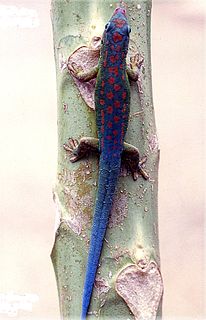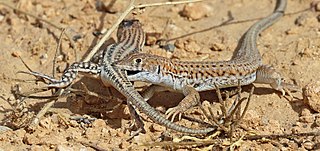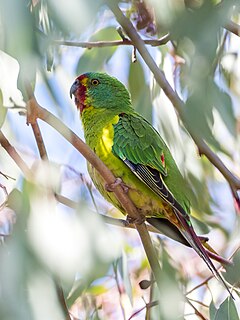
The blue-tailed day gecko is a diurnal species of gecko, a lizard in the family Gekkonidae. The species is endemic to the island Mauritius. It typically inhabits warm and humid places and dwells on different trees and bushes.

Horned lizards (Phrynosoma), also known as horny toads or horntoads, are a genus of North American lizards and the type genus of the family Phrynosomatidae. The common names refer directly to their horns or to their flattened, rounded bodies, and blunt snouts.

Acanthodactylus is a genus of lacertid lizards, commonly referred to as fringe-fingered lizards, fringe-toed lizards, and spiny-toed lizards.

The swift parrot, is a species of broad-tailed parrot, only found in southeastern Australia. The species breeds in Tasmania during the summer and migrates north to south eastern mainland Australia from Griffith-Warialda in New South Wales and west to Adelaide in the winter. It is a nomadic migrant, and it settles in an area only when there is food available.

Island tameness is the tendency of many populations and species of animals living on isolated islands to lose their wariness of potential predators, particularly of large animals. The term is partly synonymous with ecological naïvete, which also has a wider meaning referring to the loss of defensive behaviors and adaptations needed to deal with these "new" predators. Species retain such wariness of predators that exist in their environment, for example a Hawaiian goose retains its wariness of hawks, but loses such behaviors associated with mammals or other predators not found in its historical range. The most famous example is that of the dodo, which owed its extinction in a large part to a lack of fear of humans, and many species of penguin – which, although wary of sea predators, have no real land predators and therefore are very unafraid and curious towards humans.
Acanthodactylus ahmaddisii, also known commonly as the Jordanian fringe-fingered lizard and the Jordanischer Pantherfransenfinger in German, is a species of lizard in the family Lacertidae.
Acanthodactylus blanci, commonly known as the white fringe-fingered lizard or Blanc's fringe-toed lizard, is a species of lizard in the family Lacertidae. The species is endemic to North Africa.
The leopard fringe-fingered lizard, also known commonly as the Egyptian fringe-fingered lizard, is a species of lizard in the family Lacertidae. The species is endemic to North Africa.

Schreiber's fringe-fingered lizard is a species of lizard in the family Lacertidae. The species is endemic to the Middle East.
Doumergue's fringe-fingered lizard, also known commonly as Doumergue's fringe-toed lizard, is a species of lizard in the family Lacertidae.
Yehudah Leopold Werner is an Israeli herpetologist and Professor Emeritus at the Hebrew University of Jerusalem.

The Mojave fringe-toed lizard is a species of medium-sized, white or grayish, black-spotted diurnal lizard in the family Phrynosomatidae. It is adapted to arid climates and is most commonly found in sand dunes within the Mojave Desert. Fringe-toed lizards are characterized by their fringed scales on their hind toes which make locomotion in loose sand possible.
The Puerto Rican Twig Anole or Dwarf Anole is a species of small, arboreal anole endemic to Puerto Rico and primarily inhabiting the Cordillera Central from the Sierra de Cayey range in the Southeast to the central-western ranges of Maricao. A mostly grey to olive-brown bodied lizard, Anolis occultus is the smallest of the Puerto Rican Anoles with a snout to vent length of 34-42 mm. In comparison to other twig anoles, Anolis occultus is extremely cryptic through its unique sleeping behaviors and mottled pattern. Sleeping behavior including site selection minimizes the probability of predator encounter along with Anolis occultus’ extensive list of antipredator behaviors.

Bosc's fringe-toed lizard or Bosk's [sic] fringe-fingered lizard is a species of lizard in the family Lacertidae. The species is endemic to North Africa and Western Asia. Three subspecies are sometimes recognised; A. boskianus boskianus, from Lower Egypt; A. boskianus euphraticus from Iraq; and A. boskianus asper from the rest of the range; however this division is unsatisfactory because each subspecies has much variation and the differences between them are not consistent.
Acanthodactylus haasi, also known commonly as Haas' fringe-fingered lizard or Haas's fringe-toed lizard, is a species of lizard in the family Lacertidae. The species is endemic to the Arabian Peninsula.

Acanthodactylus opheodurus, also known commonly as Arnold's fringe-fingered lizard or the snake-tailed fringe-toed lizard, is a species of lizard in the family Lacertidae. The species is endemic to the Middle East.
Duméril's fringe-fingered lizard is a species of the genus fringe-fingered lizards in the Acanthodactylus scutellatus species group. It is found in the West and Central Sahara.










